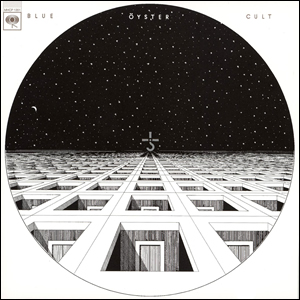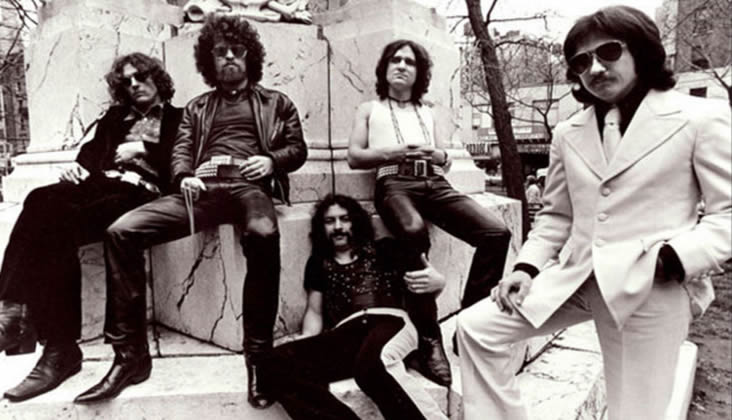Blue Öyster Cult
 The eponymous debut album by Blue Öyster Cult kicked off the year 1972 as well as the recording career of this Long Island, New York based rock group. Often referred to as “the thinking man’s heavy metal group” or “heavy metal for those who hate heavy metal”, the band drew lyrical influence from a series of literary figures, often in the fields of mystery, science fiction, or horror. Musically, the album drew influence from a variety of artists ranging from Black Sabbath to The Who and a quick listen to the CD bonus tracks of omitted tracks reflects that the band spent significant time exploring a range of styles before settling on their own specific niche.
The eponymous debut album by Blue Öyster Cult kicked off the year 1972 as well as the recording career of this Long Island, New York based rock group. Often referred to as “the thinking man’s heavy metal group” or “heavy metal for those who hate heavy metal”, the band drew lyrical influence from a series of literary figures, often in the fields of mystery, science fiction, or horror. Musically, the album drew influence from a variety of artists ranging from Black Sabbath to The Who and a quick listen to the CD bonus tracks of omitted tracks reflects that the band spent significant time exploring a range of styles before settling on their own specific niche.
Blue Öyster Cult was formed as “Soft White Underbelly” in 1967 on the campus of Stony Brook College by students Sandy Pearlman and Richard Meltzer, who both moved on to become professional rock critics by the time of the band’s debut (although, while not official members, both wrote lyrics and Pearlman was a co-producer of this album). Two band members who persisted from the earliest days were guitarist Donald “Buck Dharma” Roeser and drummer Albert Bouchard. The band was briefly signed to Elektra Records under the names “Oaxaca” and “Stalk-Forrest” and recorded many tracks that were never released and the band was soon dropped from that label. Reformed with vocalist Eric Bloom and bassist Joe Bouchard (Albert’s brother), the group settle and the name Blue Öyster Cult and were signed to Columbia Records in late 1971.
The resulting debut is a kind of dark psychedelia with layered guitar riffs and thick and muddy vocals with mysterious meanings. Songs that are tough to decipher adds to the whole mystery surrounding the band which is accented by album art, symbolism, imagery, and their very name.
 Blue Oyster Cult by Blue Oyster Cult |
|
|---|---|
| Released: January, 1972 (Columbia) Produced by: Murray Krugman, Sandy Pearlman, & David Lucas Recorded: The Warehouse, New York City, October 1971 |
|
| Side One | Side Two |
| Transmaniacon MC I’m on the Lamb But I Ain’t No Sheep Then Came the Last Days of May Stairway To the Stars Before the Kiss, a Redcap |
Screams She’s As Beautiful As a Foot Cities on Flame with Rock and Roll Workshop of the Telescopes Redeemed |
| Group Musicians | |
| Eric Bloom – Lead Vocals, Keyboards Donald Roeser – Guitars, Vocals Joe Bouchard – Bass, Vocals Allen Lanier – Guitars, Keyboards Albert Bouchard – Drums, Vocals |
|
The riff-driven “Transmaniacon MC” starts things off and alerts the listener that a very different was being brewed here. Three perfectly synced guitars are contrasted by keyboardist Allen Lanier‘s traditional rock piano. The lyrics explored the infamous murder at the Altamont festival in 1969, although not quite as eloquently as Don McClean had in “American Pie” the previous year. The follow-up, “I’m on the Lamb But I Ain’t No Sheep” is far more cryptic lyrically and less entertaining musically.
Roeser’s “Then Came the Last Days of May” speaks of a drug deal gone wrong with the country-soft melody and musical arrangement adding great contrast to the dark lyric, adding a chilling layer to the narrative. “Buck Dharma” also adds some great stinging guitar lines, making this one of the finest tracks on the album. The first side concludes with the cosmic “Stairway to the Stars” followed by the boogie rave “Before the Kiss, a Redcap”.

The most famous song on side two (as well as the entire album) is “Cities on Flame with Rock and Roll”, with an intense and powerful that even outdoes Black Sabbath (and that’s saying something for 1972). This punchy song was the band’s first single, and although it made few ripples commercially it became a cult classic (no pun intended) for fans beyond the band’s dedicated followers. Lyrically, it paints a vivid picture of “three thousand guitars” setting a city alight, an anthem on the power of rock and roll which would be watered down and regurgitated by fellow Long Islanders Kiss in the years to follow. The remainder of the side has short and interesting tunes, such as Joe Bouchard’s psychedelic track “Screams” and the eastern-flavored gem “She’s As Beautiful As a Foot”. “Workshop of the Telescopes” and “Redeemed” finish off the album with more lyrics of deep quizzicality accented by layered guitar riffs and strong rhythms.
Although Blue Öyster Cult would put out more popular albums with more radio-friendly songs in the decade that followed, they never again quite captured the hard rock density or originality of their 1972 debut.
~
Part of Classic Rock Review’s celebration of 1972 albums.





'Blue Öyster Cult' - RVM [Radio.Video.Music]
January 14, 2017 @ 5:13 am
[…] Classic Rock Review Songs that are tough to decipher adds to the whole mystery surrounding the band which is accented by album art, symbolism, imagery, and their very name. […] […]